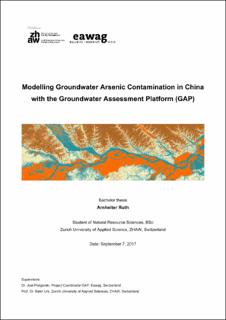Bitte benutzen Sie diese Kennung, um auf die Ressource zu verweisen:
https://doi.org/10.21256/zhaw-2150| Publikationstyp: | Thesis: Bachelor |
| Titel: | Modelling groundwater arsenic contamination in China with the Groundwater Assessment Platform (GAP) |
| Autor/-in: | Ruth, Arnheiter |
| Betreuer/-in / Gutachter/-in: | Podgorski, Joel Baier, Urs |
| DOI: | 10.21256/zhaw-2150 |
| Umfang: | 41 |
| Erscheinungsdatum: | 2017 |
| Verlag / Hrsg. Institution: | ZHAW Zürcher Hochschule für Angewandte Wissenschaften |
| Verlag / Hrsg. Institution: | Winterthur |
| Sprache: | Englisch |
| Fachgebiet (DDC): | 363: Umwelt- und Sicherheitsprobleme |
| Zusammenfassung: | Natural arsenic contamination in groundwater threatens the health of millions of people worldwide. Arsenic prediction models can help policy makers better identify areas of risk. In this study, the GIS-based Groundwater Assessment Platform (GAP, gapmaps.org) was used to produce a prediction model of China, which was compared to the hazard map of Lado et al. published in 2013. Both studies are based on logistic regression using the WHO guideline for arsenic in drinking water of 10 μg L-1, and the same 2668 arsenic measurement data and environmental variables. Lado et al. used eight environmental variables in 100 stepwise logistic regressions that were then aggregated to produce a prediction model. Using a subsample of four of Lado et al.’s variables GAP was used to produce one logistic regression for creating a map of high risk areas. Comparison of the results showed that GAP can produce results as accurate as those of Lado et al. The two maps are highly correlated and show only minor differences when binary coded. A sensitivity analysis showed that the measurement data could be reduced to less than 40% of the initial measurement data and still produces reasonably accurate results, given sufficient variability in the prediction variables used. Some technical limitations and missing information in GAP, such as the number of allowed prediction variables and what criterion is evaluated in the stepwise logistic regression, should be improved to help policymakers better assess the risk of arsenic pollution in groundwater with GAP. |
| URI: | https://digitalcollection.zhaw.ch/handle/11475/10893 |
| Lizenz (gemäss Verlagsvertrag): | Lizenz gemäss Verlagsvertrag |
| Departement: | Life Sciences und Facility Management |
| Enthalten in den Sammlungen: | Bachelorarbeiten Umweltingenieurwesen |
Dateien zu dieser Ressource:
| Datei | Beschreibung | Größe | Format | |
|---|---|---|---|---|
| 2017_Arnheiter_Ruth_BA_UI.pdf | 7.15 MB | Adobe PDF |  Öffnen/Anzeigen |
Zur Langanzeige
Ruth, A. (2017). Modelling groundwater arsenic contamination in China with the Groundwater Assessment Platform (GAP) [Bachelor’s thesis, ZHAW Zürcher Hochschule für Angewandte Wissenschaften]. https://doi.org/10.21256/zhaw-2150
Ruth, A. (2017) Modelling groundwater arsenic contamination in China with the Groundwater Assessment Platform (GAP). Bachelor’s thesis. ZHAW Zürcher Hochschule für Angewandte Wissenschaften. Available at: https://doi.org/10.21256/zhaw-2150.
A. Ruth, “Modelling groundwater arsenic contamination in China with the Groundwater Assessment Platform (GAP),” Bachelor’s thesis, ZHAW Zürcher Hochschule für Angewandte Wissenschaften, Winterthur, 2017. doi: 10.21256/zhaw-2150.
RUTH, Arnheiter, 2017. Modelling groundwater arsenic contamination in China with the Groundwater Assessment Platform (GAP). Bachelor’s thesis. Winterthur: ZHAW Zürcher Hochschule für Angewandte Wissenschaften
Ruth, Arnheiter. 2017. “Modelling Groundwater Arsenic Contamination in China with the Groundwater Assessment Platform (GAP).” Bachelor’s thesis, Winterthur: ZHAW Zürcher Hochschule für Angewandte Wissenschaften. https://doi.org/10.21256/zhaw-2150.
Ruth, Arnheiter. Modelling Groundwater Arsenic Contamination in China with the Groundwater Assessment Platform (GAP). ZHAW Zürcher Hochschule für Angewandte Wissenschaften, 2017, https://doi.org/10.21256/zhaw-2150.
Alle Ressourcen in diesem Repository sind urheberrechtlich geschützt, soweit nicht anderweitig angezeigt.